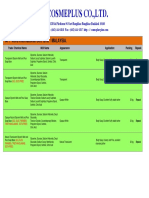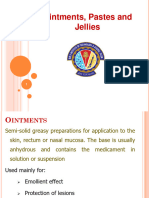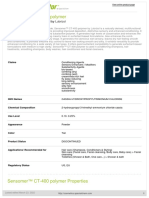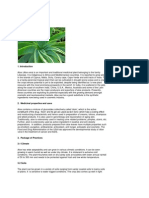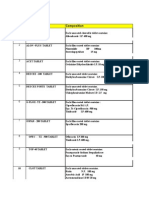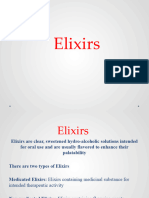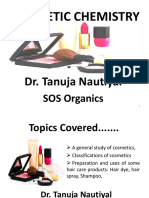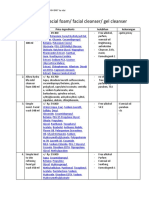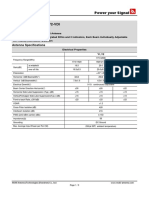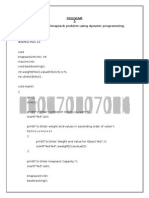Formulation and Evaluation of Aloe Vera Dental Gel Containing Clove Oil and Peppermint Oil
Formulation and Evaluation of Aloe Vera Dental Gel Containing Clove Oil and Peppermint Oil
Volume 8, Issue 5, May 2023 International Journal of Innovative Science and Research Technology
ISSN No:-2456-2165
Formulation and Evaluation of Aloe Vera Dental Gel
Containing Clove Oil and Peppermint Oil
Dr. D. K. Vir 1
1
Research Guide, Dept. Of Pharmacology,
Ideal College of Pharmacy and Research
Dr. Smita Takarkhede2
2
Principal, Ideal College Of Pharmacy And Research
Jitendra Chouhan3 ; Himanshu Devasi4 ; Ritesh Kanojiya5 ; HarshalPatil6
3,4,5,6
Research Scholar, Ideal College Of Pharmacy And Research, Bhal,
Dwarli, Hajimalang Road, Kalyan East, Maharashtra, 421306, India
Abstract:- aloe Vera is a succulent plant that has been Introduction of mouth ulcer: Mouth ulcers, also known
used for centuries in traditional medicine due to its as canker sores or aphthous ulcers, are small, painful sores
medicinal properties. It is known to have anti- that form in the mouth. They can develop on the inside of
inflammatory, anti-bacterial, and wound healing the lips, cheeks, tongue, gums, and even the roof of the
properties, making it a popular ingredient in various mouth. These sores can be quite painful and make eating
health and beauty products. Recently Aloe Vera has and speaking difficult. Mouth ulcers are quite common and
been used as a ingredient in dental gel products due to its can affect people of all ages, but they are more common in
ability to promote oral health. Clove oil and peppermint women than men.
oil are also popular natural ingredients known for their
medical properties. Clove oil known for its analgesic and There are several different types of mouth ulcers, and
anti inflammatory properties making it an effective each type has a different cause. The most common type of
ingredient in dentalproducts.peppermint oils known for mouth ulcer is called a minor aphthous ulcer. These ulcers
its refreshing and cooling properties making it popular are small, shallow sores that usually heal on their own
ingredient in dental products. within a week or two. Major aphthous ulcers are less
common but more severe, and can take several weeks to
The combination of aloe Vera, clove oil and heal. Herpetiform ulcers are a type of ulcer that look like
peppermint oil in a dental gel can provide several clusters of small, painful sores. These ulcers are the least
benefits for oral health. This research paper aims to common and can take the longest to heal.
evaluate effectiveness of Aloe Vera dental gel containing
clove oil and peppermint oil in promoting oral health. Treatment for mouth ulcers depends on the type and
severity of the ulcer. Minor aphthous ulcers usually heal on
I. INTRODUCTION their own within a week or two and do not require treatment.
However, more severe ulcers may require prescription
The buccal cavity, commonly known as the mouth, is a medication, such as corticosteroids or antiviral drugs. Over-
complex anatomical structure that plays a crucial role in the-counter medications, such as numbing gels and
several physiological processes, including speech, taste, mouthwashes, can help alleviate pain and promote healing.
digestion, and oral hygiene. The mouth is composed of In some cases, lifestyle changes, such as avoiding certain
various structures, including the tongue, teeth, gums, palate, foods or reducing stress, may also be recommended.
and the inner lining of the cheeks and lips. The mouth also
harbors a diverse microbial community, including beneficial II. MATERIALS
and harmful bacteria, which can impact oral health.
Therefore, maintaining good oral hygiene is essential to A. Aloe vera gel:
prevent several dental and oral diseases. Aloe vera contains a variety of bioactive compounds,
including polysaccharides, anthraquinones, enzymes,
The use of aloevera dental gel containing clove oil and vitamins, and minerals. These compounds work together to
peppermint oil can provide several benefits for the buccal provide the plant's therapeutic effects. Aloe vera has been
cavity. The gel can help to prevent the growth of harmful found to be effective in treating both gastric and peptic
bacteria in the mouth, reducing the risk of dental caries, ulcers. The polysaccharides in aloe vera help to reduce
gingivitis, and periodontitis. The anti-inflammatory inflammation and promote healing of the ulcerated tissues.
properties of aloe vera and peppermint oil can also help to Aloe vera also contains compounds that help to reduce the
reduce inflammation and swelling of the gums, promoting production of stomach acid, which can help to prevent
overall oral health. further damage to the ulcer.
IJISRT23MAY966 www.ijisrt.com 1506
Volume 8, Issue 5, May 2023 International Journal of Innovative Science and Research Technology
ISSN No:-2456-2165
B. Clove Determination of pH
The primary constituents are volatile oil (15–20%), The pH of gel was determined using digital pH meter
gallotannins (10–15%), resin, chromone, and eugenin. The by dipping the glass electrode completely into the gel
ingredients of the volatile oil found in the oil glands of system.The physicochemical properties, especially pH value
cloves include eugenol (70 to 90 percent), eugenol acetate, of dental medicines, have significant influence on the health
caryophyllenes, traces of esters, ketones, and alcohol. Clove of oral cavity tissues. The pH of formulations should
oil is known for its analgesic and antiseptic properties, correspond to the value of saliva pH (5.5–8.0).
which can provide relief from pain and inflammation caused
by mouth ulcers. Determination of viscosity
The viscosity range of dental gels can vary from around
C. Peppermint 100 cps to over 10,000 cps. However, the viscosity
Menthol is the main component of peppermint oil, along range for most dental gels falls between 1000 and 5000
with lesser amounts of menthyl acetate, isovalerate, cps. The optimal viscosity of a dental gel depends on
menthone, cineol, dormant pinene, limonene, and other various factors such as its intended use, the patient's
compounds. When it is cooled to a low temperature (-22°C), oral health condition, and the specific requirements of
the menthol isolates. Both the ester and the alcoholic the treatment
components of the oil are responsible for the oil's flavouring Viscosities of the formulated gels were determined
qualities, but only the alcoholic components are responsible using Brookfield Viscometer, spindle no. 7 and spindle
for the medicinal value. Peppermint oil contains menthol, a speed 60 rpm at 25°C were used for gels, the
compound that has a cooling and soothing effect on the corresponding dial reading on the viscometer was
affected area. This can help alleviate the pain associated noted.
with mouth ulcers. Peppermint oil can promote healing of
mouth ulcers by increasing blood flow to the affected area Determination of Extrude ability
and promoting cell regeneration. The following are the general steps for conducting a
tube extrudability test of dental gel:
D. Preparation of gel Select a tube of dental gel that has been stored at room
Add aloe vera gel obtained from species Aloe temperature for at least 24 hours prior to testing.
barbadensis in a beaker, add equal amount of distilled Use a balance to weigh the tube and record its original
water in a beaker . weight.
Now take whole sample into container and grind it with Attach the tube to a standard tube extruder that is
the help of mixer so that uniform texture of aloe vera designed to apply a constant force to the tube during the
liquid can be obtained. test.
Take accurately weighed amount of glycerin in another Apply the force to the tube using the extruder, and
beaker and add measured amount of xantham gum collect the dental gel that is extruded from the tube into
slowly with continuous stirring in it , stir it properly so a pre-weighed container.
that homogenous mixture is obtained . Weigh the container with the extruded dental gel and
Add aloe vera liquid in above mixture.. Now add clove record its weight.
oil and peppermint oil slowly with continuous Calculate the percentage of dental gel extruded by
stirring.Add measured amount of citric acid in it. dividing the weight of the extruded gel by the original
The product will be obtained from stirring it vigorously. weight of the tube, and multiply the result by 100.
All the prepared gels were then subjected to evaluation Repeat the test at least three times and calculate the
tests in order to select the best formulation average percentage of dental gel extruded.
E. Evaluation of gel formulation:
Physical appearance
The physical appearance of the formulation was
checked visually
Color: The color of the formulations was checked out
against white background
Odor: The odor of the gels was checked by mixing the
gel in water and taking the smell
Greasiness: The greasiness was assessed by the
application on to the skin.
Consistency: The consistency was checked by applying
on skin.
IJISRT23MAY966 www.ijisrt.com 1507
Volume 8, Issue 5, May 2023 International Journal of Innovative Science and Research Technology
ISSN No:-2456-2165
Table1: Determination of Extrude ability
Ingredient Category Quantity
Aloe vera liquid Base 20 ml
Clove oil API 1ml
Peppermint oil API 1ml
Glycerin Solubilizer 5ml
Gum xantham Thickening agent 1.2gm
Citric acid Preservative 0.35gm
Distilled water _ q.s
The normal range for tube extrudability for dental gel Then the solutions were filtered through 0.45 mm
is typically between 80% and 100% of the original weight of membrane filters and proper dilutions were made and
the tube.F1,F2,F3,F4ejects 4.6,4.7,4.75,4.5 gm respectively solutions were subjected to the spectrophotometric
out of 5gm. analysis.
The drug content was calculated from the given formula.
Determination of Homogeneity
Homogeneity testing is performed to ensure that a batch Drug content (%) = (Absorbance of test /Absorbance
or sample of a substance is uniform in composition and of standard) x 100
properties. In dentistry, homogeneity testing is often used
for dental materials, such as cements, impression materials, Antimicrobial Susceptibility test of gel
and composites, to ensure that each unit or batch of the The following are the general steps for performing AST
material meets the required quality standards. for dental gels:
Isolate the microorganism: The microorganism causing
Visual Inspection: The material is visually inspected the dental infection is isolated from a clinical sample,
for any visible signs of non-uniformity, such as variations in such as saliva or dental plaque, and grown in culture.
color, texture, or consistency. Inoculate the culture: The bacterial culture is then
inoculated onto a special medium that allows the
All the developed gels were tested for homogeneity by
microorganism to grow uniformly.
visual inspection after the gels have been set in the
Add antimicrobial agents: Small discs impregnated with
container. They were tested for their appearance and
different antimicrobial agents are placed on the surface
presence of any aggregates.
of the culture. These discs contain specific
Determination of spreadability concentrations of the antimicrobial agents being tested.
The normal range for spreadability is usually between 1 Incubate the culture: The culture is then incubated
and 7 centimeter(cm), depending on the viscosity and other under specific conditions for a set amount of time.
rheological properties of the gel. Observe the results: After incubation, the plates are
examined to determine the size of the zone of inhibition
Determination of drug content around each disc. The zone of inhibition is the area
The general procedure for the drug content test is as around the disc where the microorganisms cannot grow
follows: because of the antimicrobial agent.
The drug content of the gel formulations was determined
by dissolving an accurately weighed quantity 1 g of gel F. Stability study:
in 100 ml of solvent (a mixture of ethanol and phosphate Physically stability study test of the formulation was
buffer pH 6.8 (60:40) for formulations of clove and carried for one week at temperature of 37° C. The
peppermint oil). formulation was found to be Physically stable at temperature
The solutions were kept for shaking for 4 h and then kept of 37 °C within one week.
for 6 h for complete dissolution of the formulations.
IJISRT23MAY966 www.ijisrt.com 1508
Volume 8, Issue 5, May 2023 International Journal of Innovative Science and Research Technology
ISSN No:-2456-2165
Table 2: Composition Of Gel Formulation
Ingredients F1 F2 F3 F4
Aloe vera liquid (ml) 20 20 20 20
Clove oil (ml) 1 1 1 1
Peppermint oil (ml) 1 1 1 1
Glycerin (ml) 5 5 5 5
Gum xantham (gm) 1 1.1 1.2 1.3
Citric acid (gm) 0.35 0.35 0.35 0.35
Distilled water (ml) q.s q.s q.s q.s
Table 3: Characteristics Of Gel Formulation
Formulation Appearance pH Viscosity Spreadability Tube extrudeability Homogeneity
(cps) (cm) (%)
F1 Pale yellow 6.43 1130 6.9 92.1 Good
F2 Pale yellow 6.54 3340 6.8 94.2 Very good
F3 Pale yellow 6.66 4560 6.8 95.1 Very good
F4 Pale yellow 6.73 5300 6.7 90.2 Good
Table 4: Absorbance’s of batches while considering clove oil as standard
Batches Absorbance
F1 0.570
F2 0.574
F3 0.585
F4 0.567
The absorbance of standard clove oil at 278 nm is 0.650
Table 5: Absorbance’s of batches while considering peppermint oil as standard
Batches Absorbance
F1 0.357
F2 0.361
F3 0.369
F4 0.344
The absorbance of standard peppermint oil at 234 nm is 0.420.
Table 6: Drug Content Of Formulation
Formulation Drug Content (%) for clove oil Drug Content (%) for peppermint oil
F1 87.69 85
F2 88.46 85.95
F3 90 87.85
F4 87.23 81.90
Table 7: Antimicrobial activity of formulation
Microorganisms Zone of inhibition in mm (F3)
Streptococcus oralis 28.26
Table 8: stability studies (evaluation tests after one week)
Formulation Appearance pH Viscosity Spreadability Tube extrudeability Homogeneity
(cps) (cm) (%)
F1 Pale yellow 6.43 1150 6.86 92 Good
F2 Pale yellow 6.54 3380 6.75 93 Very good
F3 Pale yellow 6.66 4600 6.79 95 Very good
F4 Pale yellow 6.73 5390 6.68 90 Good
III. CONCLUSION be further used commercially to develop dental gels after
conducting clinical trials on human beings. Nevertheless
The clove oil and peppermint oil was found to have further research is still needed in order to determine if they
antibacterial activity against Streptococcus oralis. The efficiently could substitute the synthetic ulcer gel.
formulations developed from clove oil and peppermint oil
using aloe vera as a base showed significant results so it can
IJISRT23MAY966 www.ijisrt.com 1509
Volume 8, Issue 5, May 2023 International Journal of Innovative Science and Research Technology
ISSN No:-2456-2165
REFERENCES
[1.] Extraction and Characterization of Peppermint
(Menthapiperita) Essential Oil and its Assessment as
Antioxidant and Antibacterial
[2.] Formulation And Evaluation Of Topical Anti Acne
Formulation Of Coriander Extract
[3.] Formulation And Development Of Dental Gel
Containing Clove Oil For The Treatment Of Human
Periodontal Diseases
[4.] Formulation And Evaluation Of Dental Gel
Containing Essential Oil Of Coriander Against Oral
Pathogens
[5.] Yellanki SA, Singh J and Manvi FV. Formulation,
Characterization and Evaluation of Metronidazole gel
for local treatment of periodontitis. International
Journal of Pharm and Bio Sciences 2010; 2: 1-9.
[6.] Botelho MA, Nogueira AP, Bastos GM, Fonseca
SGC et al.Antimicrobial activity of the essential oil
from Lippiasidoides, carvacrol and thymol against
oral pathogens. Brazilian Journal of Medical and
Biological Research 2007; 40: 349-356.
http://dx.doi.org/10.1590/ S0100-
879X2007000300010 PMid:17334532
[7.] Sartoretto A, Lúcia MA, Delarmelina C et al.
Composition and antimicrobial activity of
essential oils from aromatic plants used in Brazil.
Brazilian Journal of Microbiology
[8.] 2004; 35: 275-280.http://dx.doi.org/10.1590/S1517-
83822004000300001
[9.] Pai MR, Acharya LD, Kapur N. Evaluation of anti
plaque activity of Azadirachtaindica Leaf extract gel -
a 6-week clinical study. J Ethnopharmacol 2004; 90:
99-103. http://dx.doi.org/10.1016/ j.jep.2003.09.035
PMid:14698516
IJISRT23MAY966 www.ijisrt.com 1510
You might also like
- Niir Complete Technology Book On Herbal Beauty Products With Formulations ProcessesNo ratings yetNiir Complete Technology Book On Herbal Beauty Products With Formulations Processes19 pages
- Aquaxyl: Hydraconcept: An Innovative Moisturizing and Restructuring TechnologyNo ratings yetAquaxyl: Hydraconcept: An Innovative Moisturizing and Restructuring Technology38 pages
- Formulation and Evaluation of Salicylic Acid Face SerumNo ratings yetFormulation and Evaluation of Salicylic Acid Face Serum10 pages
- Formulation and Evaluation of Antimicrobial Polyherbal Ointment 2155 9538 1000154No ratings yetFormulation and Evaluation of Antimicrobial Polyherbal Ointment 2155 9538 10001544 pages
- Formulation and Evaluation of Herbal SoapNo ratings yetFormulation and Evaluation of Herbal Soap6 pages
- Synopsis Report On Organic Cosmetics by PCTENo ratings yetSynopsis Report On Organic Cosmetics by PCTE10 pages
- Formulation of Herbal Conditioner Shampoo by Using PDFNo ratings yetFormulation of Herbal Conditioner Shampoo by Using PDF9 pages
- Mouth/Nose/Eyes/Ears: 2. 1.1 Lip and Skin Butter100% (1)Mouth/Nose/Eyes/Ears: 2. 1.1 Lip and Skin Butter2 pages
- BASF Nutrition Ingredients - Global Product Catalog - Human January - 2009No ratings yetBASF Nutrition Ingredients - Global Product Catalog - Human January - 20099 pages
- TDS SEPINOV EMT 10 & WEO - Presentation-3No ratings yetTDS SEPINOV EMT 10 & WEO - Presentation-383 pages
- Preparation and Evaluation of Catharanthus Roseus Face Sheet Mask SerumNo ratings yetPreparation and Evaluation of Catharanthus Roseus Face Sheet Mask Serum4 pages
- Formulation and Evaluation of Herbal Lipstick Containing Antifungal AgentNo ratings yetFormulation and Evaluation of Herbal Lipstick Containing Antifungal Agent13 pages
- 7446 Intimate Hygiene Slide GB March 2016 LDNo ratings yet7446 Intimate Hygiene Slide GB March 2016 LD38 pages
- Zemea (R) Propanediol Deodorant OnePagerNo ratings yetZemea (R) Propanediol Deodorant OnePager1 page
- Technical Data Sheet: Biogenic Sallic-210No ratings yetTechnical Data Sheet: Biogenic Sallic-2102 pages
- Natural Bug Spray Recipe To Make at HomeNo ratings yetNatural Bug Spray Recipe To Make at Home8 pages
- Cosmetic Chemistry: Dr. Tanuja NautiyalNo ratings yetCosmetic Chemistry: Dr. Tanuja Nautiyal67 pages
- A. Face Wash/ Facial Foam/ Facial Cleanser/ Gel Cleanser: No. Merk/brand Price-Ingredients Kelebihan KekuranganNo ratings yetA. Face Wash/ Facial Foam/ Facial Cleanser/ Gel Cleanser: No. Merk/brand Price-Ingredients Kelebihan Kekurangan14 pages
- Uvinul, T-Lite™ and Z-COTE Grades: Cosmetic SolutionsNo ratings yetUvinul, T-Lite™ and Z-COTE Grades: Cosmetic Solutions28 pages
- Personal Care: Preservatives Multifunctional AdditivesNo ratings yetPersonal Care: Preservatives Multifunctional Additives16 pages
- Herbal Gel For Management of Mouth UlcersNo ratings yetHerbal Gel For Management of Mouth Ulcers5 pages
- Perception, Attitude, and Readiness in Artificial Intelligence Adoption among Academic Librarians in the Bicol Region Librarians Council (BRLC)No ratings yetPerception, Attitude, and Readiness in Artificial Intelligence Adoption among Academic Librarians in the Bicol Region Librarians Council (BRLC)6 pages
- Assessment of Underground Water Quality of Gosa Landfill Site of the Federal Capital Territory, Abuja NigeriaNo ratings yetAssessment of Underground Water Quality of Gosa Landfill Site of the Federal Capital Territory, Abuja Nigeria11 pages
- Transition to Telepsychotherapy: Experiential Perspective of Debutant TherapistsNo ratings yetTransition to Telepsychotherapy: Experiential Perspective of Debutant Therapists6 pages
- Investigating the Interplay between Climate Change and Sustainable Environment Development: Challenges, Strategies and Future DirectionsNo ratings yetInvestigating the Interplay between Climate Change and Sustainable Environment Development: Challenges, Strategies and Future Directions11 pages
- Crude Oil Price Volatility and its Impact on Nigeria’s Balance of Trade: An Empirical Assessment (2000–2023)No ratings yetCrude Oil Price Volatility and its Impact on Nigeria’s Balance of Trade: An Empirical Assessment (2000–2023)13 pages
- Monte Carlo-Based Modeling of 2-D Ising Systems Using Metropolis Algorithm, Simulation Techniques, Thermodynamic Behavior and Magnetization PatternsNo ratings yetMonte Carlo-Based Modeling of 2-D Ising Systems Using Metropolis Algorithm, Simulation Techniques, Thermodynamic Behavior and Magnetization Patterns16 pages
- Optimal Voltage Regulation in Standalone Photovoltaic Systems Using Model Predictive Control and MOGANo ratings yetOptimal Voltage Regulation in Standalone Photovoltaic Systems Using Model Predictive Control and MOGA8 pages
- Developing Gamified Educational Technologies to Enhance Learning and Motivate Student Engagement in Education: A Quantitative Study Using Human-Computer Interaction (HCI)No ratings yetDeveloping Gamified Educational Technologies to Enhance Learning and Motivate Student Engagement in Education: A Quantitative Study Using Human-Computer Interaction (HCI)16 pages
- Unlocking the Therapeutic Power of Coriander: A Review of Coriandrum Sativum’s Bioactive Compounds and Health BenefitsNo ratings yetUnlocking the Therapeutic Power of Coriander: A Review of Coriandrum Sativum’s Bioactive Compounds and Health Benefits15 pages
- A Review on Gold Nanoparticles: Properties, Synthesis and Biomedical Application in Drug Delivery and Cancer TherapyNo ratings yetA Review on Gold Nanoparticles: Properties, Synthesis and Biomedical Application in Drug Delivery and Cancer Therapy6 pages
- Analyzing Social Communication Deficits in Autism Using Wearable Sensors and Real-Time Affective Computing SystemsNo ratings yetAnalyzing Social Communication Deficits in Autism Using Wearable Sensors and Real-Time Affective Computing Systems17 pages
- A Phytochemical Evaluation of Sierra Leonean Cassia siamea: A Source of Bioactive CompoundsNo ratings yetA Phytochemical Evaluation of Sierra Leonean Cassia siamea: A Source of Bioactive Compounds5 pages
- Cost Comparative Analysis of Solar/Utility and Diesel/Utility Hybrid Power System for a Typical Residential BuildingNo ratings yetCost Comparative Analysis of Solar/Utility and Diesel/Utility Hybrid Power System for a Typical Residential Building8 pages
- Analysis of the Role of Websites, Design, and Performance Metrics in Improving Company Performance in Medan CityNo ratings yetAnalysis of the Role of Websites, Design, and Performance Metrics in Improving Company Performance in Medan City4 pages
- ResumeMatch: Intelligent Resume Enhancement & Job Fit AnalysisNo ratings yetResumeMatch: Intelligent Resume Enhancement & Job Fit Analysis7 pages
- Real - Time Recognition of Cardiovascular Conditions from ECG Images with Deep LearningNo ratings yetReal - Time Recognition of Cardiovascular Conditions from ECG Images with Deep Learning10 pages
- A MIC-MAC-Based Structural Exploration of Determinants Impacting Investment SensitivityNo ratings yetA MIC-MAC-Based Structural Exploration of Determinants Impacting Investment Sensitivity8 pages
- Design and Implementation of a GPS-GSM based Real-Time Vehicle Theft Tracking System for Urban Security in UgandaNo ratings yetDesign and Implementation of a GPS-GSM based Real-Time Vehicle Theft Tracking System for Urban Security in Uganda7 pages
- A Decade of Genome Editing: Comparative Review of ZFN, Talen, and CRISPR/CAS9No ratings yetA Decade of Genome Editing: Comparative Review of ZFN, Talen, and CRISPR/CAS910 pages
- Assessing the Achievements of the Re-Alignment of an Industry Educatiocal Based System in SocietyNo ratings yetAssessing the Achievements of the Re-Alignment of an Industry Educatiocal Based System in Society5 pages
- Enhancing Model Accuracy for Keypoint-Based Sign Language Recognition using Optimized Neural Network ArchitecturesNo ratings yetEnhancing Model Accuracy for Keypoint-Based Sign Language Recognition using Optimized Neural Network Architectures7 pages
- Architecture as a Reflection of Cultural Continuity: A Study of Traditional TrendsNo ratings yetArchitecture as a Reflection of Cultural Continuity: A Study of Traditional Trends3 pages
- EduTech Portal: An AI-Powered Student Assistant ChatbotNo ratings yetEduTech Portal: An AI-Powered Student Assistant Chatbot12 pages
- Smart Narrator Robot: Enhancing Experiential Learning through Conditional AutonomyNo ratings yetSmart Narrator Robot: Enhancing Experiential Learning through Conditional Autonomy6 pages
- Development of Mirror Biosensor in Saliva pH Measurement in Health ServicesNo ratings yetDevelopment of Mirror Biosensor in Saliva pH Measurement in Health Services7 pages
- Continuing Training and Professional Performance of Primary School Teachers in Tchad: The Case of Teachers in the Farchana Refugee CampNo ratings yetContinuing Training and Professional Performance of Primary School Teachers in Tchad: The Case of Teachers in the Farchana Refugee Camp7 pages
- Evaluating the Impact of Shopee Mall on Consumer Purchase: Basis for Developing an Effective Marketing PlanNo ratings yetEvaluating the Impact of Shopee Mall on Consumer Purchase: Basis for Developing an Effective Marketing Plan61 pages
- Analysis of the Export Competitiveness of Indonesia's Horticultural Fruit Products in the International MarketNo ratings yetAnalysis of the Export Competitiveness of Indonesia's Horticultural Fruit Products in the International Market8 pages
- Behavior Addiction in Adolescents Post COVID 19: A Systematic Mental Health ReviewNo ratings yetBehavior Addiction in Adolescents Post COVID 19: A Systematic Mental Health Review8 pages
- Enhancing the Robustness of Computer Vision Models to Adversarial Perturbations Using Multi-Scale Attention MechanismsNo ratings yetEnhancing the Robustness of Computer Vision Models to Adversarial Perturbations Using Multi-Scale Attention Mechanisms14 pages
- Power Your Signal: Antenna SpecificationsNo ratings yetPower Your Signal: Antenna Specifications3 pages
- Ijser: Hybrid Data Encryption and Decryption Using Rsa and Rc4No ratings yetIjser: Hybrid Data Encryption and Decryption Using Rsa and Rc410 pages
- Power System Iii: Automatic Generation Control (AGC)No ratings yetPower System Iii: Automatic Generation Control (AGC)54 pages
- CHAPTER 6. Right Triangel and TRIGONOMETRY PDFNo ratings yetCHAPTER 6. Right Triangel and TRIGONOMETRY PDF57 pages
- (Ebook) Micro Electro Mechanical System Design by James J. Allen ISBN 0824758242instant download100% (3)(Ebook) Micro Electro Mechanical System Design by James J. Allen ISBN 0824758242instant download53 pages
- Stratigraphy and Morphotectonics of Karoo Deposits of The Northern Selous Basin Tanzania - WopfnerKaaya1991No ratings yetStratigraphy and Morphotectonics of Karoo Deposits of The Northern Selous Basin Tanzania - WopfnerKaaya199117 pages
- Spyder-Ide - Spyder-Notebook - Jupyter Notebook Integration With SpyderNo ratings yetSpyder-Ide - Spyder-Notebook - Jupyter Notebook Integration With Spyder6 pages
- Software Customisation Reference ManualNo ratings yetSoftware Customisation Reference Manual253 pages
- GEA FILTER GB-Luftfilter-DF-K6-2011-07-150dpi PDFNo ratings yetGEA FILTER GB-Luftfilter-DF-K6-2011-07-150dpi PDF70 pages
- Elematic Hollow-Core Plank: Building SystemsNo ratings yetElematic Hollow-Core Plank: Building Systems32 pages
- CNT230018-8 C3 HRSG Deaerator Storage Tank - MTreportNo ratings yetCNT230018-8 C3 HRSG Deaerator Storage Tank - MTreport6 pages
- Transmitter Turndown Ratio, Set Span and Zero Span Instrumentation ToolsNo ratings yetTransmitter Turndown Ratio, Set Span and Zero Span Instrumentation Tools5 pages







